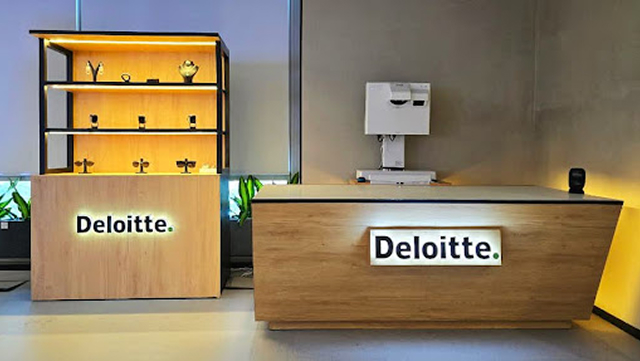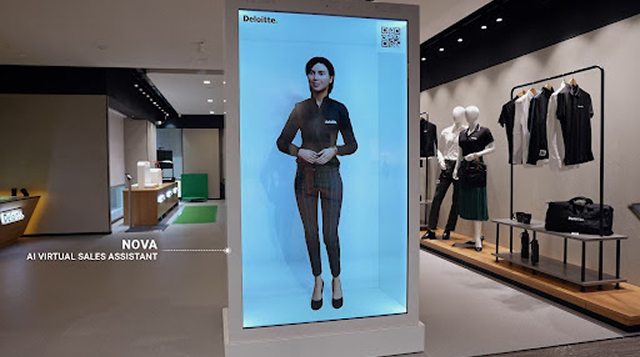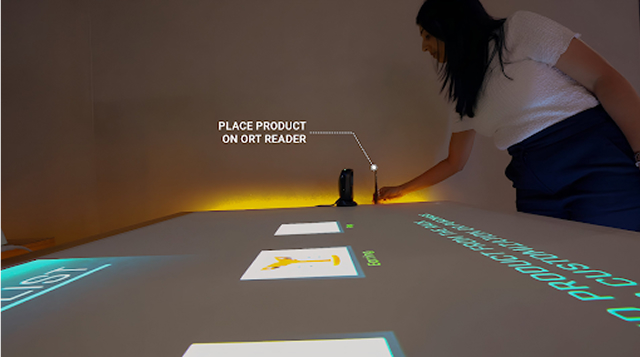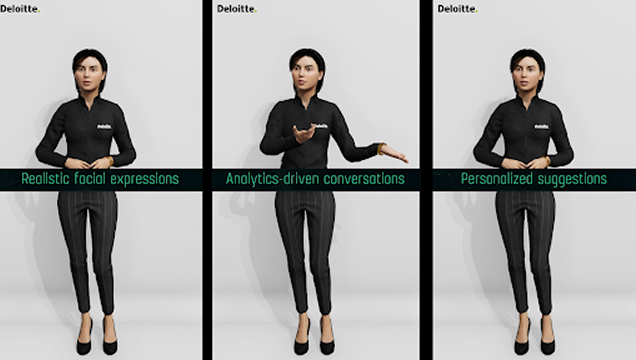
Let's be honest, how many more "transformative" PowerPoint decks can you actually sit through?
We’ve all been there. You're in a dark boardroom, looking at slide 74 of a 150-slide deck. Your eyes are glazing over. Someone is using words like "synergistic," "omnichannel," and "AI-driven paradigm"... but it all just feels like abstract buzzwords.

In the world of high-stakes enterprise consulting, this is the billion-dollar problem. The greatest challenge isn't coming up with world-changing ideas; it's making them tangible. It's trying to sell a complex, AI-powered, omnichannel future to a Fortune 500 CEO... using a 2D slide.
It doesn't work. Words and charts just fall flat.
Deloitte faced this exact dilemma. So, they asked a simple, revolutionary question: What if, instead of telling a client what the future of retail looks like, we could just let them walk through it?
The answer wasn't a better presentation. It was to build the future itself.
We partnered with them to create the Dot Hub, the firm's first-ever global AI retail experience center in Bangalore. It’s not a showroom. It’s a living, breathing ecosystem designed to turn abstract strategies into an interactive journey.
And today, we're taking you inside.
The Dot Hub isn't just a collection of cool gadgets. It’s a meticulously architected five-stage journey. It’s designed to compress months of consulting dialogue into a single, eye-opening session.

And it all starts with the one thing everyone in the store has: their phone.
The entire experience is anchored by a Progressive Web App (PWA). The moment a "customer" (in this case, a visiting C-suite exec) walks in, they're onboarded through this app.
This PWA is their "digital passport." It's the invisible thread that connects every single touchpoint. It holds their preferences, their wishlist, and their unique profile. It ensures the entire journey is 100% personalized, learning and adapting to them in real-time. This simple app is the key to solving the biggest problem in omnichannel: making all the different systems actually talk to each other.

Forget scrolling through a boring online catalog. The discovery phase here is pure magic. Clients walk up to the Holobox, and product SKUs are brought to life as photorealistic, interactive holograms.
Want to see that new dress? A life-size holographic model appears, and you can see the fabric move. Want to buy a new piece of tech? Spin the digital twin around 360 degrees. Every interaction, every product you pause on, is quietly noted by your PWA, building a dynamic profile of your interests before you’ve even said a word.

This is where things get really hands-on. Once you've selected a product (say, a bracelet), you move to the Object Recognition Table (ORT). This is where "phygital" (physical + digital) comes alive.
You don't just click buttons. You place a physical sample item onto the table's surface.
Instantly, the table recognizes the product and fires up a stunning, touch-interactive creative canvas.
From here, you're the designer. You can swap gemstones, change metal types, and see the price update in real-time. It seamlessly blends the tactile, satisfying feel of a physical product with the infinite possibilities of a digital configurator. This isn't just "customization"—it's a creative experience.

Floating above all this is the brain. The system is designed to provide help exactly when you need it, in two powerful ways.
1. Nova, the AI Sales Assistant: The true centerpiece. Nova is a sophisticated, life-size conversational AI. She’s not just a dumb chatbot. Powered by machine learning, she can provide context-aware suggestions ("I see you're looking at the ruby bracelet; you might like the matching earrings") and answer complex questions in a natural, human-like way. Nova isn't just scripted. She has realistic facial expressions, understands the analytics from your PWA, and makes truly personalized suggestions.
2. The Human Expert: But what if you have a really high-level question? The system knows AI can't handle everything. With one tap, a real human sales expert can be patched in instantly from a remote studio, appearing on the same screen to offer that high-empathy, human touch. This, right here, is the real future: AI handling the immediate, data-driven needs, freeing up humans for high-value consultation.
The journey culminates in a checkout process so smooth, it's almost invisible.
Everything you've done—the items you explored on the Holobox, the bracelet you designed on the ORT, the suggestions from Nova—is already synced to your PWA. The transition from in-store exploration to final purchase is totally frictionless.
A few taps on your own device, and the transaction is done. The boundaries between the physical store and your digital profile are completely erased.
The Deloitte Dot Hub isn't just cool tech. It's a strategic weapon. It proves, without a shadow of a doubt, that the best way to sell a complex vision is to let people experience it.
By creating a tangible, "phygital" world, Deloitte has transformed its sales process from "telling" to "showing."
Clients don't hear about AI personalization; they have a conversation with Nova. They don't see a wireframe of a customer journey; they physically walk it.
Here’s a detailed analysis of the shift this represents:
Strategic Pillar | The Old Way ("Telling") | The New Way ("Showing") |
Client Comprehension | Abstract. "I think I get it." The client has to use their imagination. | Concrete. "I see how this works." The client uses it themselves. |
Value Proposition | A Claim. "Our AI will boost engagement." | A Demonstration. The client feels their own engagement boosted. |
Sales Cycle | Long. Months of follow-ups, demos, and "what if" calls. | Compressed. The entire value chain is proven in one 60-minute session. |
Building Confidence | Low. "This seems risky." It's just an idea on a slide. | High. "This works." The client has already touched it, used it, and seen it work. |
The Final Question | "Can you send me the deck?" | "When can we start?" |
That table highlights the most important, high-intent variable in any enterprise sale: Confidence.
A slide deck is a claim. An experience center is proof.
When an executive asks, "Can you send me the deck?" it's a polite stall. It means, "I'm not convinced." When they ask, "When can we start?" it means their internal risk has been neutralized. The Dot Hub isn't just a sales tool; it's a de-risking asset. It takes a terrifying, multi-million dollar "what if" and turns it into a tangible, proven, and exciting "what is."
This is the new standard for selling any complex, high-value solution. The question is no longer if this technology works, but how you will deploy it.
This is more than just a case study about Deloitte. It's a blueprint for the future of any complex sale.
We've all hit a wall with 2D presentations. We're overloaded with abstract ideas and buzzwords. The Dot Hub proves that the new currency for building trust isn't a slicker slide deck—it's a more tangible, memorable, and interactive experience.
The technology is here. The strategy is proven. The only question left is the one you should be asking your own team:
Why are we still just presenting our vision when we could be letting our clients experience it?
The next slide deck isn't going to win the big deal. A tangible, confidence-building experience will.
If you're a leader tired of slide decks and ready to give your clients a tangible experience of your vision, our team is the one that builds these.
Let's build your Dot Hub together.
Contact Us Now: